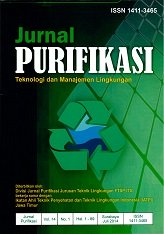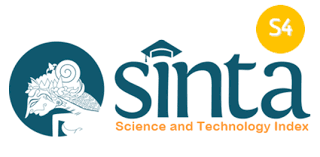AKTIVASI KIMIA-FISIK LIMBAH SERUTAN ROTAN MENJADI KARBON AKTIF CHEMICAL-PHYSICAL ACTIVATION OF RATTAN SHAVINGS WASTE TO PRODUCE ACTIVATED CARBONS
Main Article Content
Abstract
Limbah rotan dari industri kerajinan dan mebel berpotensi untuk dijadikan sebagai bahan baku pembuatan karbon aktif karena memiliki kandungan holoselulosa dan kadar karbon yang tinggi. Penelitian ini bertujuan untuk menganalisis efektifitas dari aktivasi kimia menggunakan larutan natrium klorida (NaCl) yang dilanjutkan dengan aktivasi fisik dalam pembuatan karbon aktif berbahan dasar limbah serutan rotan. Pembuatan karbon aktif diawali dengan proses karbonisasi pada suhu 250°C selama 1 jam. Selanjutnya aktivasi kimia menggunakan larutan NaCl dengan variasi konsentrasi 10%, 15% dan 20% serta waktu perendaman selama 10, 15 dan 20 jam. Aktivasi fisik dilakukan dengan pembakaran pada suhu 700°C selama 30 menit. Analisis karakteristik fisik-kimia karbon aktif mengacu pada SNI 06-3730-95, meliputi kadar air, fixed carbon, dan iodine number, sedangkan perhitungan luas permukaan spesifik karbon aktif dilakukan dengan Metode Sears. Hasil penelitian ini menunjukkan bahwa kondisi optimum aktivasi kimia terjadi pada konsentrasi NaCl 10% dan lama perendaman 10 jam dengan hasil analisis kadar air 2.90%, fixed carbon 72.70%, iodine number 994.59 mg/g dan luas permukaan 1587.67 m²/g. Peningkatan fixed carbon, iodine number dan luas permukaan karbon aktif berbanding terbalik dengan peningkatan konsentrasi NaCl dan lama waktu perendaman, sedangkan peningkatan kadar air pada karbon aktif berlaku sebaliknya.
Rattan waste from handicraft and furniture industry could potentially be used as raw material of activated carbon due to high content of holoselulosa and carbon. This paper investigates the effectiveness of chemical activation using sodium chloride (NaCl) followed by physical activation in the making of activated carbon-based on rattan shavings waste. Preparation of the activated carbon began with the carbonization process at 250°C for 1 hour. Furthermore chemical activation using a variation of NaCl concentrations 10%, 15% and 20% as well as the time of immersion 10, 15 and 20 hours. Physical activation was done by burning at 700°C for 30 minutes. Analysis of the physical and chemical characteristics of the activated carbon was referred to the SNI 06-3730-95, including of moisture content, fixed carbon and iodine number, while the calculation of the specific surface area was done by the Sears’s method. The results of this study showed that the optimum conditions of chemical activation occurred in impregnation by NaCl 10% for 10 hours. The water content, fixed carbon, iodine number and surface area of activated carbon was 2.90%, 72.70%, 994.59 mg/g and 1587.67 m²/g respectively. The increase values of fixed carbon, iodine number, and surface area was inversely proportional to the increase of NaCl concentration and the length of impregnation time, while the increase of water content applied vice versa.
Downloads
Article Details
Submission of a manuscript to Jurnal Purifikasi means that the work has never been published in another journal and is not under consideration for publication elsewhere. The author hereby agrees to submit the copyright of the manuscript and its contents to Jurnal Purifikasi, if accepted for publication. Accepted manuscripts will be published in printed form where the ISSN is bound in printed form, not in online form (pdf). Authors are not allowed to publish their work in other forms (journals) without permission from the Jurnal Purifikasi manager.
By submitting a manuscript, the author is deemed to know all the rights and obligations attached to each manuscript.








